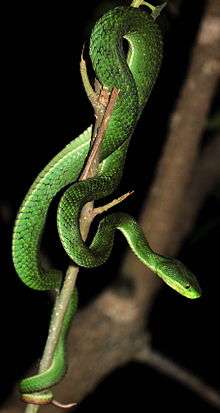Trimeresurus septentrionalis
Trimeresurus septentrionalis, commonly known as the northern white-lipped pit viper,[3] is a venomous pit viper species endemic to Bangladesh, Nepal and India.[4]
| Trimeresurus septentrionalis | |
|---|---|
 | |
| Scientific classification | |
| Kingdom: | Animalia |
| Phylum: | Chordata |
| Class: | Reptilia |
| Order: | Squamata |
| Suborder: | Serpentes |
| Family: | Viperidae |
| Genus: | Trimeresurus |
| Species: | T. septentrionalis |
| Binomial name | |
| Trimeresurus septentrionalis Kramer, 1977 | |
| Synonyms | |
Description
Total length males 610 mm, females 730 mm.[2]
The head scalation consists of 10-11(12) upper labials, the first of which are fused to the nasal. The head scales are small, subequal and feebly imbricate, smooth or weakly keeled. The supraoculars are narrow and undivided with 9-11 interocular scales between them. The temporal scales are smooth.[2]
Midbody there are 21 longitudinal dorsal scale rows. There are 162-172 ventrals in males, 160-181 in females. The subcaudals are paired and number 68-83 in males, 55-71 in females. The hemipenes are without spines.[2]
The colour pattern is green above. The belly is green, yellowish or white below. A faint ventrolateral stripe present in all males, but absent in females. The end of tail not mottled brown.[2]
Holotype: MHNG 1404.31[2]
Geographic range
It is found in Bangladesh, Nepal and northwestern India (Simla).[4] The type locality is given as "Nepal 83o 55' 28o 15' 1500 m (Nähe Pokhara)". Regenass & Kramer (1981) list the type locality as "Hyangcha (Nepal) 83o 55' E.L. 28o 15' N.B. 1500 m". Holotype: MHNG 1404.31.[1]
Taxonomy
Elevated to a species, T. septentrionalis, by Giannasi et al. (2001).[5] Returned to a subspecies, T. a. septentrionalis, by Leviton et al. (2003). Elevated to a species in another genus, Cryptelytrops septentrionalis, by Malhotra & Thorpe (2004). Returned to genus Trimeresurus and placed in subgenus (Trimeresurus) by David et al. (2011). (See synonyms.)
References
- McDiarmid RW, Campbell JA, Touré T. 1999. Snake Species of the World: A Taxonomic and Geographic Reference, Volume 1. Herpetologists' League. 511 pp. ISBN 1-893777-00-6 (series). ISBN 1-893777-01-4 (volume).
- Trimeresurus septentrionalis at the Reptarium.cz Reptile Database
- Gumprecht A, Tillack F, Orlov NL, Captain A, Ryabov S. 2004. Asian Pitvipers. GeitjeBooks. Berlin. 1st Edition. 368 pp. ISBN 3-937975-00-4.
- Leviton AE, Wogan GOU, Koo MS, Zug GR, Lucas RS, Vindum JV. 2003. The Dangerously Venomous Snakes of Myanmar, Illustrated Checklist with Keys. Proc. Cal. Acad. Sci. 54 (24):407-462. PDF Archived 2006-08-30 at the Wayback Machine at Smithsonian National Museum of Natural History, Division of Amphibians and Reptiles. Accessed 8 August 2006.
- Giannasi N, Thorpe RS, Malhotra A. 2001. The use of amplified fragment length polymorphism in determining species trees at fine taxonomic levels: analysis of a medically important snake, Trimeresurus albolabris. Molecular Ecology 10: 419-426. PDF at Homepage of Professor Roger Stephen Thorpe, University of Wales, Bangor. Accessed 8 August 2006.
Further reading
- Einfalt P. 2002. Haltung und Vermehrung von Trimeresurus albolabris (Gray 1842). Elaphe 10 (4): 31-36.
- Gumprecht A. 2001. Die Bambusottern der Gattung Trimeresurus Lacépède Teil IV: Checkliste der Trimeresurus-Arten Thailands. Sauria 23 (2): 25-32
- Kramer E. 1977. Zur Schlangenfauna Nepals. Rev. suisse Zool. 84 (3): 721-761.
- Parkinson CL. 1999. Molecular systematics and biogeographical history of Pit Vipers as determined by mitochondrial ribosomal DNA sequences. Copeia 1999 (3): 576-586
- Tu MC, Wang HY, Tsai MP, Toda M, Lee WJ, Zhang FJ, Ota H. 2000. Phylogeny, Taxonomy, and Biogeography of the Oriental Pit Vipers of the Genus Trimeresurus (Reptilia: Viperidae: Crotalinae): A Molecular Perspective. Zoological Science 17: 1147-1157.
- The Reptile Database (http://reptile-database.reptarium.cz/species?genus=Trimeresurus&species=septentrionalis)